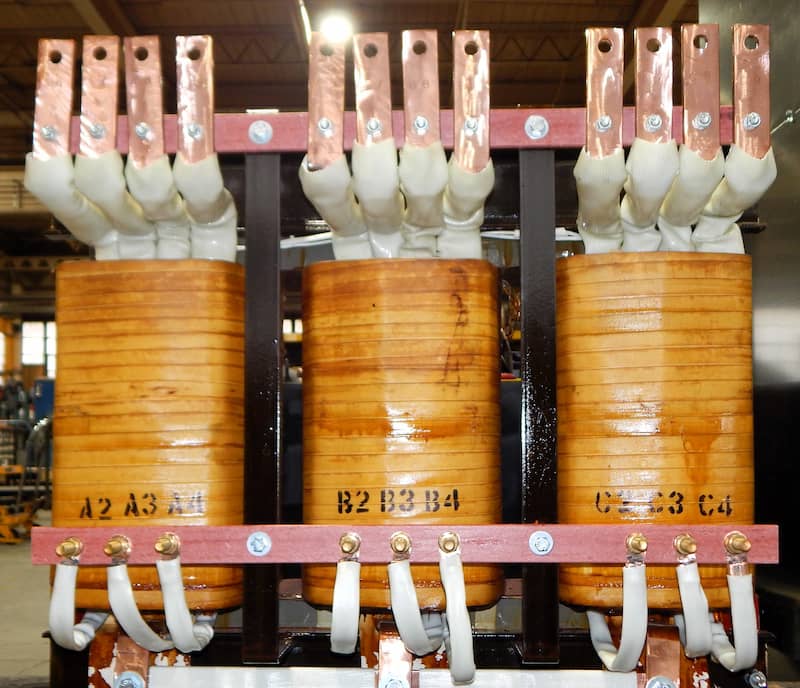Transforming Solar and Wind Energy with Custom Transformer Solutions
The renewable energy industry continues to expand rapidly, driven by increasing demands for cleaner, more sustainable power sources. As governments...
Control Transformer designs high-performance, fully customized magnetic solutions that are tailored to your power, frequency, and environmental needs.
Control Transformer has more than 70 years of experience delivering reliable, custom-engineered magnetic solutions across numerous industries.
4 min read
By: Control Transformer, Inc. on Feb 27, 2025 11:43:21 AM

In today’s industrial landscape, custom transformers play a critical role in ensuring efficient and reliable power distribution across a variety of industries, including oil & gas, mining, manufacturing, and renewable energy. Each of these sectors relies on transformers tailored to their unique power requirements, ensuring smooth operations and enhanced efficiency. Whether used for machinery control, motor drives, power conditioning, or critical infrastructure, the right transformer can make all the difference in system performance and longevity.
Selecting a custom transformer is not just about meeting voltage and current needs; it involves understanding the operational environment, compliance requirements, and long-term reliability. Buyers must consider key factors such as energy efficiency, thermal management, and durability to prevent costly downtime and maintenance. Partnering with an experienced manufacturer can streamline the sourcing process and help buyers secure a transformer that perfectly aligns with their application’s needs. Here’s what buyers need to know before sourcing a custom transformer.
Before reaching out to a manufacturer, clearly outline the specifications required for your transformer. Consider factors such as:
Control Transformer has been delivering superior-quality transformers since 1953, growing from a one-man operation to a 30,000-square-foot facility. Founded on the principle that quality comes first, the company continues to maintain its reputation by using the highest-grade materials and expert craftsmanship.
The core material of a transformer plays a crucial role in efficiency, energy loss, and overall performance. Control Transformer utilizes high-quality M6 grade/29-gauge grain-oriented electrical steel in its transformer cores. This material is specifically chosen for its superior magnetic properties, reducing core losses and increasing efficiency in power applications. The C-3 insulating coating applied to this steel further enhances its durability and performance, ensuring long-lasting and reliable operation in demanding environments.
While grain-oriented silicon steel is the industry standard for power transformers due to its efficiency and low hysteresis losses, other core materials may be considered for specialized applications:
Understanding the advantages of each material will help buyers select the best option for their specific needs, but for most power applications, M6 grain-oriented electrical steel remains the gold standard for efficiency and reliability.
Heat dissipation is a crucial factor in transformer longevity. Buyers should determine whether natural air cooling, forced air cooling, or liquid cooling is required based on load conditions and operational environments. Proper thermal management ensures reliability and prevents overheating issues.
While off-the-shelf transformers may meet general requirements, many applications benefit from custom designs. A custom transformer allows for:
Buyers should also consider the trade-offs between custom and standard transformers. While custom designs offer flexibility and optimization, they may come with longer lead times and higher upfront costs compared to off-the-shelf options.
Ensuring compliance with industry standards is critical when sourcing a transformer. Buyers should verify that the selected transformer meets certifications such as:
Neglecting compliance can lead to regulatory issues, increased liability, and operational inefficiencies. Learn more about Control Transformer’s Policies and Compliance.
Choosing the right transformer manufacturer is just as important as defining your specifications. When evaluating potential suppliers, consider:
When investing in a transformer, quality should never be compromised for cost savings. Control Transformer stands out with a defect return rate of just 0.0013%, ensuring that failures are virtually nonexistent. By using top-tier materials like:
The Total Cost of Ownership (TCO) equation proves the minimal risk involved: Cost for Control Transformer Units x Return for Defects = TCO $51,735.00 x 1.0013 = $51,802.26 Increase in risk of failure = $67.26
One failed transformer can result in significant downtime, repair costs, and reputational damage. Investing in high-quality designs eliminates these risks and ensures reliability.
For quick reference, here’s a checklist to guide buyers through the sourcing process:
Sourcing a custom transformer requires careful planning, from defining application requirements to selecting the right manufacturer. By understanding the critical factors that influence transformer design, buyers can make informed decisions that optimize efficiency, reliability, and cost-effectiveness.
At Control Transformer, we specialize in designing and manufacturing high-quality custom transformers tailored to your needs. Contact us today to discuss your project and find the best solution for your application.

The renewable energy industry continues to expand rapidly, driven by increasing demands for cleaner, more sustainable power sources. As governments...

How Control Transformer Powers a Greener Future In today’s energy-conscious world, businesses are under increasing pressure to meet regulatory...

In today’s industrial landscape, custom transformers play a critical role in ensuring efficient and reliable power distribution across a variety of...
Tell us about your magnetics needs. We'll give you an estimate of the resources needed to engineer a product to meet your exact specs, complete with a preliminary design.